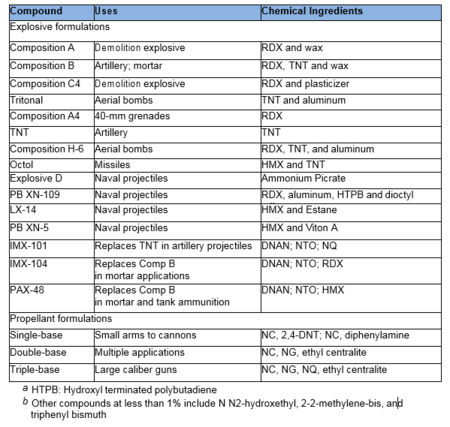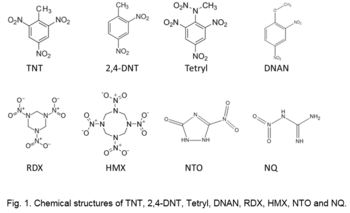Difference between revisions of "User:Debra Tabron/sandbox"
Debra Tabron (talk | contribs) |
Debra Tabron (talk | contribs) |
||
| Line 13: | Line 13: | ||
Explosive materials are commonly classified according to the speed of the chemical reaction wave that propagates through the material. If the wave velocity is greater than the speed of sound (supersonic), the material is said to undergo detonation and is considered an explosive. If the wave propagation velocity is less than the speed of sound, the material is considered to undergo deflagration (rapid burning) and is often used as a propellant<ref name= "USEPA2012FIP"/>. | Explosive materials are commonly classified according to the speed of the chemical reaction wave that propagates through the material. If the wave velocity is greater than the speed of sound (supersonic), the material is said to undergo detonation and is considered an explosive. If the wave propagation velocity is less than the speed of sound, the material is considered to undergo deflagration (rapid burning) and is often used as a propellant<ref name= "USEPA2012FIP"/>. | ||
| − | Common military explosives are mixtures consisting of one or more explosive compounds including trinitrotoluene (TNT), 1,3,5-hexahydro-1,3,5-trinitrotriazine or Research Development Explosive (RDX), octrahydro-1,3,5,7- tetranitro-1,3,5,7-tetrazocine or High Melting Explosive (HMX), and 2,4,6- trinitro-phenylmethylnitramine (tetryl) and ammonium picrate. However, the US military is replacing many of these materials with Insensitive Munitions (IM) to reduce risks of accidental detonation. IM materials will burn, rather than explode, when subjected to fast or slow heating, bullets, shrapnel, shaped charges, or the detonation of another nearby munition. Important components of IM include 2,4-dinitroanisole (DNAN), nitroguanidine (NQ), 3-nitro-1,2,4-triazol-5-one (NTO) and other traditional munitions components (RDX, HMX). | + | Common military explosives are mixtures consisting of one or more explosive compounds including trinitrotoluene (TNT), 1,3,5-hexahydro-1,3,5-trinitrotriazine or Research Development Explosive (RDX), octrahydro-1,3,5,7- tetranitro-1,3,5,7-tetrazocine or High Melting Explosive (HMX), and 2,4,6- trinitro-phenylmethylnitramine (tetryl) and ammonium picrate. However, the US military is replacing many of these materials with Insensitive Munitions (IM) to reduce risks of accidental detonation. IM materials will burn, rather than explode, when subjected to fast or slow heating, bullets, shrapnel, shaped charges, or the detonation of another nearby munition. Important components of IM include 2,4-dinitroanisole (DNAN), nitroguanidine (NQ), 3-nitro-1,2,4-triazol-5-one (NTO) and other traditional munitions components (RDX, HMX). Common military explosives, propellants and IM formulations are shown in Table 1. |
Propellant formulations often contain several components. The primary component is often nitrocellulose (NC), which is combined with other EM compounds including nitroglycerin (NG), NQ, DNT, HMX, burn rate modifiers, binders or plasticizers, and stabilizers. Gun propellants usually are single component based (e.g., NC), double based (e.g., NC and NG), or triple based (e.g., NC, NG, and NQ). | Propellant formulations often contain several components. The primary component is often nitrocellulose (NC), which is combined with other EM compounds including nitroglycerin (NG), NQ, DNT, HMX, burn rate modifiers, binders or plasticizers, and stabilizers. Gun propellants usually are single component based (e.g., NC), double based (e.g., NC and NG), or triple based (e.g., NC, NG, and NQ). | ||
| Line 28: | Line 28: | ||
{| class="wikitable" style="margin-left: auto; margin-right: auto; border: none;" | {| class="wikitable" style="margin-left: auto; margin-right: auto; border: none;" | ||
|- | |- | ||
| − | ! style="background-color:#CEE0F2;"|'''Explosive'''!!style="background-color:#CEE0F2;"| '''CAS'''!! style="background-color:#CEE0F2;"|'''Formula''' | + | ! style="background-color:#CEE0F2;"|'''Explosive'''!!style="background-color:#CEE0F2;"| '''CAS'''!! style="background-color:#CEE0F2;"|'''Formula'''!!style="background-color:#CEE0F2;"|'''Molecular Weight [g/mol]'''!!style="background-color:#CEE0F2;"|'''Aqueous Solubility at 25 C [mg/L]'''!!style="background-color:#CEE0F2;"|''' Log K<sub>ow</sub>'''!!style="background-color:#CEE0F2;"|'''Vapor Pressure at 20 C |
| − | !''' Log K<sub>ow</sub>'''!! '''Vapor Pressure at 20 C | ||
[mm Hg]''' | [mm Hg]''' | ||
Revision as of 19:09, 5 January 2017
Energetic Materials (EM) are chemicals used in formulations as propellants, pyrotechnics, and explosives in weapon systems, munitions and blasting agents. This article introduces these materials, major physical and chemical properties, and fate in the environment. Important chemical groups include nitroaromatics (e.g. 2,4,6-trinitrotoluene (TNT) and 2,4-dinitrotoluene (2,4-DNT), nitramines (e.g. hexahydro-1,3,5-trinitro-1,3,5-triazine (RDX) and octahydro-1,3,5,7-tetranitro-1,3,5,7-tetreazocine (HMX)), nitrate esters (e.g. nitroglycerin (NG), pentaerythritol tetranitrate (PETN)), and nitrocellulose (NC). Ammonium perchlorate (AP) is commonly used as a propellant in solid rock fuel and is addressed in a separate article . Insensitive munitions (IM) are energetics in newer military explosives, and are generally considered more stable than traditional explosives.
CONTRIBUTOR(S): Dr. Kevin Finneran and Dr. Robert Borden, P.E.
Key Resource(s): EPA Federal Facilities Forum Issue Paper: Site Characterization for Munitions Constituents, EPA/505/S-11/001, 2012.[1]
Explosives and Propellants
Explosive materials are commonly classified according to the speed of the chemical reaction wave that propagates through the material. If the wave velocity is greater than the speed of sound (supersonic), the material is said to undergo detonation and is considered an explosive. If the wave propagation velocity is less than the speed of sound, the material is considered to undergo deflagration (rapid burning) and is often used as a propellant[1].
Common military explosives are mixtures consisting of one or more explosive compounds including trinitrotoluene (TNT), 1,3,5-hexahydro-1,3,5-trinitrotriazine or Research Development Explosive (RDX), octrahydro-1,3,5,7- tetranitro-1,3,5,7-tetrazocine or High Melting Explosive (HMX), and 2,4,6- trinitro-phenylmethylnitramine (tetryl) and ammonium picrate. However, the US military is replacing many of these materials with Insensitive Munitions (IM) to reduce risks of accidental detonation. IM materials will burn, rather than explode, when subjected to fast or slow heating, bullets, shrapnel, shaped charges, or the detonation of another nearby munition. Important components of IM include 2,4-dinitroanisole (DNAN), nitroguanidine (NQ), 3-nitro-1,2,4-triazol-5-one (NTO) and other traditional munitions components (RDX, HMX). Common military explosives, propellants and IM formulations are shown in Table 1.
Propellant formulations often contain several components. The primary component is often nitrocellulose (NC), which is combined with other EM compounds including nitroglycerin (NG), NQ, DNT, HMX, burn rate modifiers, binders or plasticizers, and stabilizers. Gun propellants usually are single component based (e.g., NC), double based (e.g., NC and NG), or triple based (e.g., NC, NG, and NQ).
Physical and Chemical Properties
The structure, physical and chemical of explosive materials control their fate and transport in the environment. Figure 1 shows the chemical structure of common EM.
Table 2 provides the molecular mass, aqueous solubility, Log octanol-water partition coefficient (Log Kow), and vapor pressure of common explosive materials. With the exception of NG, the major EM are solids at ambient temperatures. Although NG is a liquid, it is commonly used as a component of double- and triple-base propellants, with the solid polymeric NC. Aqueous solubility of EM varies dramatically between the different materials and can have an important influence on their mobility in the environment. Organic compounds with a high Kow are more likely to sorb to organic carbon in soil or bioaccumulate; however, EM tend to be high in nitrogen, and by definition, are strong oxidizing agents. EM materials tend to form crystals. The vapor pressure of these materials is relatively low, so volatilization is not an important removal mechanism for most EM.
| Explosive | CAS | Formula | Molecular Weight [g/mol] | Aqueous Solubility at 25 C [mg/L] | Log Kow | Vapor Pressure at 20 C
[mm Hg] | |||||
|---|---|---|---|---|---|---|---|---|---|---|---|
| TNT | 118-96-7 | C7H5N3O6 | 227.13c | 130c | 1.60c | 1.99E-4c | |||||
| RDX | 121-82-4 | C3H6N6O6 | 222.26d | 56.4i | 0.87d | 1 to 4 E-9d | |||||
| HMX | 2691-41-0 | C4H8N8O8 | 296.16a | 4.5i | 0.165i | 3.3E-14a | |||||
| Tetryl | 479-45-8 | C7H5N5O8 | 287.14a | 80a | 5.7E-9 (25 C) a | ||||||
| 2,4-DNT | 121-14-2 | C7H6N2O4 | 182.15a | 300 (22 C) f | 1.98f | 1.47E-4f | |||||
| 2,6-DNT | 606-20-2 | C7H6N2O4 | 182.15a | 180 (22 C) f | 1.72 or 2.10f | 5.67E-4f | |||||
| 2-ADNT | 35572-78-2 | C7H7N3O4 | 197.17a | 2800a | 4.0E-5a | ||||||
| 4-ADNT | 19406-51-0 | C7H7N3O4 | 197.17a | 2800a | 2.0E-5a | ||||||
| NTO | 932-64-9 | C2H2N4O3 | 130.08 | 2000m | 0.858m | ||||||
| DNAN | 119-27-7 | C7H6N2O5 | 198.13j | 213 o, p | 1.58o, p | 1.E-4 (25 C) j | |||||
| NQ | 556-88-7 | CH4N4O2 | 104.07 | 4,400n | -0.89j
0.21l |
1.00E-9 (est) j | |||||
|
a = Thiboutout et al 2002[2], b = Pennington et al 2006 Final Report [5], c = EPA Technical fact sheet for TNT[6], d = EPA Technical fact sheet for RDX[7], f = EPA Technical fact sheet for DNT[8], g = EPA Technical fact sheet for perchlorate [9], h = McGrath (1995)[10], i = Monteil-Rivera et al. 2004[11], j = DNAN WEEL FINAL[12], l = DRDC 2011[13], m = NTO WEEL FINAL[14], n = van der Schalie 1985[15], o = Hawari 2014[16], p = Hawari et al 2015[17] Table 2. Physical and Chemical Properties of important explosives and propellants | |||||||||||
References
- ^ 1.0 1.1 U.S. Environmental Protection Agency (USEPA), 2012. EPA Federal Facilities Forum Issue Paper: Site Characterization for Munitions Constituents, EPA/505/S-11/001, 2012. Report pdf
- ^ 2.0 2.1 Thiboutot, S., Ampleman, G. and Hewitt, A.D., 2002. Guide for characterization of sites contaminated with energetic materials (No. ERDC/CRREL-TR-02-1) U.S. Armu Environmental Center SFIM-AEC-TC-CR-200170. Report pdf
- ^ Jenkins, T.F., 2007. Energetic Munitions Constituents on DoD Training Ranges: Deposition, Accumulation, and Appropriate Characterization Technology, In: SERDP and ESTCP Technical Exchange Meeting on DoD Operational Range Assessment and Management Approaches, SERDP and ESTCP, Arlington, VA.
- ^ Fung, V., Schreiber, B., Patel, C., Samuels, P., Vinh, P. and Zhao, X.L., 2012. Process Improvement and Optimization of Insensitive Explosive IMX-101. In Insensitive Munitions & Energetic Materials Technology Symposium (IMEMTS) & National Defense Industrial Association (NDIA): Las Vegas, NV, USA.
- ^ Pennington, J.C., Jenkins, T.F., Ampleman G., Thiboutot, S., Brannon, J.M., Hewitt, A.D., Lewis, J., Brochu, S., Diaz, E., Walsh, M.R., Walsh, M.E., Taylor, S., Lynch, J.C., Clausen, J., Ranney, T.A., Ramsey, C.A., Hayes, C.A., Grant, C.L., Collins, C.M., Bigl, S.R., Yost, S., Dontsova, K., 2006. Distribution and fate of energetics on DoD test and training ranges: Final Report . ERDC TR-06-13. Vicksburg, MS: U.S. Army Engineer Research and Development Center. Report pdf
- ^ U.S. Environmental Protection Agency (USEPA), 2014. EPA Technical Fact Sheet - 2,4,6-Trinitrotoluene (TNT). Report pdf
- ^ U.S. Environmental Protection Agency (USEPA), 2014. EPA Technical Fact Sheet for RDX. Report pdf
- ^ U.S. Environmental Protection Agency (USEPA), 2014. EPA Technical Fact Sheet for DNT. Report pdf
- ^ U.S. Environmental Protection Agency (USEPA), 2014. EPA Technical Fact Sheet for Perchlorate Report pdf
- ^ McGrath, C.J. 1995. Review of formulations for processes affecting the subsurface transport of explosives. IRRP-95-2, U.S. Army Engineer Waterways Experiment Station, Vicksburg, MS Report pdf
- ^ Monteil-Rivera, F., Paquet, L., Deschamps, S., Balakrishnan, V.K., Beaulieu, C. and Hawari, J., 2004. Physico-chemical measurements of CL-20 for environmental applications: Comparison with RDX and HMX. Journal of Chromatography A, 1025(1), pp.125-132.doi: 10.1016/j.chroma.2003.08.060
- ^ OARS, 2014. Workplace environmental exposure level (WEEL) 2,4-Dinitroanisole (DNAN). OARS, Cincinnati, OH. Report pdf
- ^ DRDC. 2011. Annual report 2010-2011. Environmental fate and ecological impact of emerging energetic chemicals (DNAN and its Amino-Derivatives, NTO, NQ, FOX-7, and FOX-12). Prepared by J. Hawari. NRC# 53363, Defense Research and Development Canada, National Research Council of Canada, Montréal, Québec
- ^ OARS, 2014. Workplace environmental exposure level (WEEL) 3-Nitro-1,2,4-Triazol-5-One (NTO). OARS, Cincinnati, OH. Report pdf
- ^ Schalie, W.H., 1985. The toxicity of nitroguanidine and photolyzed nitroguanidine to freshwater aquatic organisms (No. USAMBRDL-TR-8404). Army Medical Bioengineering Research and Development Laboratory, Fort Detrick, MD. Report pdf
- ^ Hawari, J., 2014. Annual Report 2013-2014. Environmental fate and ecological impact of emerging energetic chemicals (ADN, DNAN and its Amino-Derivatives, PETN, NTO, NQ, FOX-7, and FOX-12) and an insensitive formulation. Defense Research and Development Canada, National Research Council of Canada, Montréal, Québec. Report pdf
- ^ Hawari, J., Monteil-Rivera, F., Perreault, N.N., Halasz, A., Paquet, L., Radovic-Hrapovic, Z., Deschamps, S., Thiboutot, S. and Ampleman, G., 2015. Environmental fate of 2, 4-dinitroanisole (DNAN) and its reduced products. Chemosphere, 119, pp.16-23.doi:10.1016/j.chemosphere.2014.05.047

